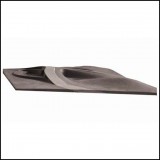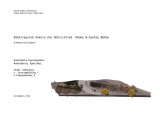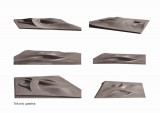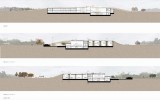Supervisors:
2012
The main subject of this thesis is to design an art school at the Cultural Grove of N. Ionia, Volos, Greece.
Until the 1970's the grove was used as heliport. Gradually hills ,ponds, small footpaths and routes were added ,as well as the Open Public Theatre and Cultural Center of N.Ionia were constructed.Its current form is not the final one, as the respective technical service continues to form it through the years.Although there are serious signs of decline, the park is a green lung of oxygen for the area and is frequently visited by residents of N.Ionia.
In Greece the Art High Schools exist as institution since 2004. There are already three Art High Schools in Gerakas, in Ambeloki (Thessaloniki) and Heraklion. Until the afternoon the normal courses of general high schools are taught. After lunch (there is a school restaurant) students continue until 16:00 with artistic courses. There are common classes for all students and field courses. The fields the students are encouraged to choose among dancing, theater-cinema and visual arts. Their introduction is via admission exams.
The choice of designing a high school, and not a full school campus, was made both for limiting the exploitation of the natural landscape of the grove, and preparing students to admission to higher artistic institutions in a more rural environment.
The process of erosion-corrosion-sedimentation was the basic design concept, since the transportation and replacement of natural materials by the water and / or wind can be found in correspondence with the process of continuous movement, learning and expression of students and young artists. The landscape of the grove creates external stimuli to young artists contributing to their artistic fulfillment.
The building is located in the northwestern part of the grove and is divided into three basic volumes, which through oblique, planted, passable roofs result in small hills, harmonizing with the landscape. These three parts serve both basic and artistic education and are joined into an atrium, where common and cultural events take place . Apart from the basic and artistic classrooms, there is an auditorium-gym, a restaurant, a library and a video library. The presence of two courtyards, one of which is intended primarily for art classes and events, was also important .
From the very beginning, we focused on the building orientation, the use of natural light, wherever necessary, the sufficient shading and use of bioclimatic design strategies to ensure comfortable and healthy working and learning conditions in the school.
Much attention was paid so that the design would not disturb the landscape and character of the grove. The aim was to highlight the grove and transformate it into a semi-urban attraction, with the prospect of further common and cultural uses.
Finally, attention to avoid exclusion of residents from the use of the grove and the routes was severely paid. The paths were redefined according to the typology of the original concept, planting was reinforced , especially around the school, and smaller ponds were added to achieve physical fencing around the school area.






